A tuxedo is the most formal garment most guys own. When styled right, the tux suggests elegance and timeless style. Nailing it isn’t hard, but attention to detail is essential. If you’re wondering how to wear a tuxedo for a wedding, gala, fundraiser, or other black tie event, we’re here to help you choose and style your tux. This tuxedo guide will explore different types of tuxedos, how to style them properly, and the key elements of black tie attire. If you are headed to a summer wedding that isn’t black tie, you can pause here and check out our guide to summer weddings.
Quick Refresher – What is Black Tie?
There are plenty of articles covering this topic in great depth. If you’re reading this tuxedo guide, you may already know what a black tie is. But just to be safe, here’s a quick refresher:
The standard black tie ensemble consists of a black tuxedo, a white tuxedo shirt, a black bow tie, and polished dress shoes.
What is a Tuxedo?
This might feel basic, but a lot of guys will wear a black suit to a black-tie event, and while that’s closer than a teal suit, it’s not quite a black tie. The defining characteristics of a tuxedo are:
- Satin Lapels – A signature feature of the tuxedo, typically found in peak, shawl, or notch lapel styles.
- Satin Stripes on Trousers – Running down the side of the leg for added formality.
- Bow Tie & Formal Shirt Requirement – Worn with a tuxedo shirt instead of a standard dress shirt.
- Formal Accessories – Cummerbunds, waistcoats, and tuxedo studs complete the look but are not a requirement.
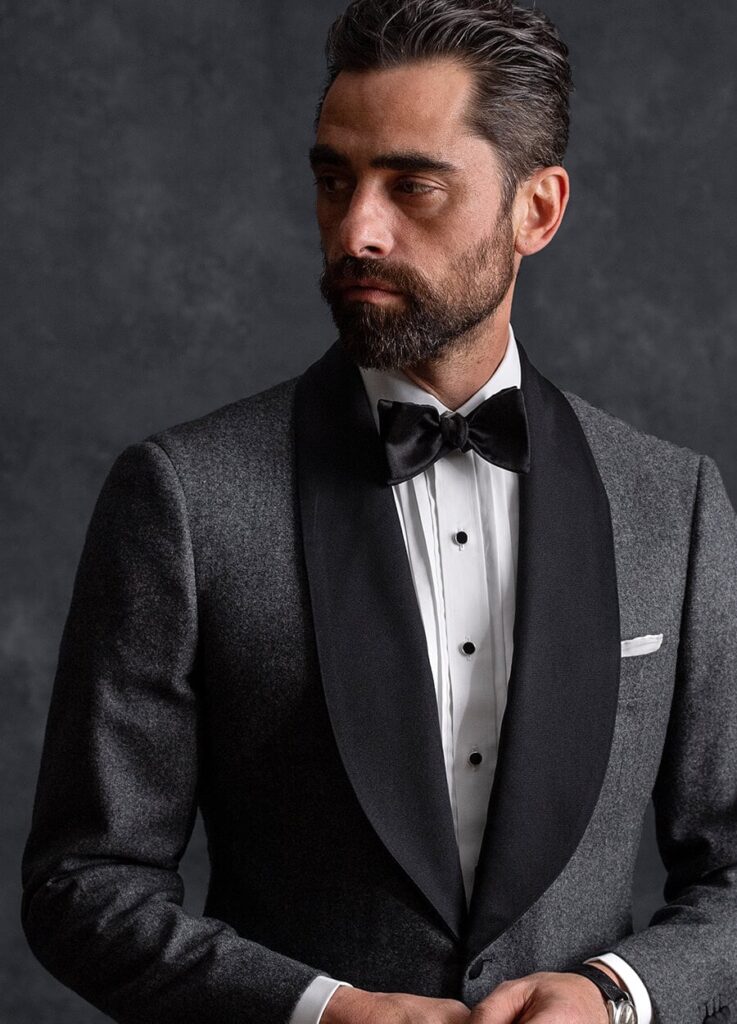

The Different Types of Tuxedos & How to Choose the Right One
There is a surprising amount of variety in tuxedos, offering an opportunity for self-expression. Understanding the differences can help you decide whether you prefer a classic tuxedo style or something less common. Let’s start with the jacket construction.
Single-Breasted vs. Double-Breasted Tuxedos
- Single-Breasted Tuxedo – The most common and versatile option, the single-breasted tuxedo features one row of buttons.
- Double-Breasted Tuxedo – A double-breasted tuxedo jacket features two parallel columns of buttons on the front, with a wide, overlapping closure that fastens on one side, creating a structured and formal silhouette.
Single-breasted tuxedos have always been more common. The double-breasted tuxedo, the descendant of naval jackets, can have a more formal or bolder feel. If you’re interested in learning more about the history of the double-breasted suit, check out our full write-up.
Tuxedo Lapel Styles
- Peak Lapel – A peak lapel sticks out past the rest of the collar, like a mountain peak. In regular suiting, this is more common on double-breasted jackets. When it comes to tuxedos, it’s common to see it on single-breasted jackets as well.
- Notch Lapel – A less formal and less common lapel style where the top of the lapel and the bottom of the collar meet at an angled cut-out or “notch,” creating a small, triangular gap.
- Shawl Lapel – Sleek and rounded, offering a vintage-inspired, softer aesthetic.

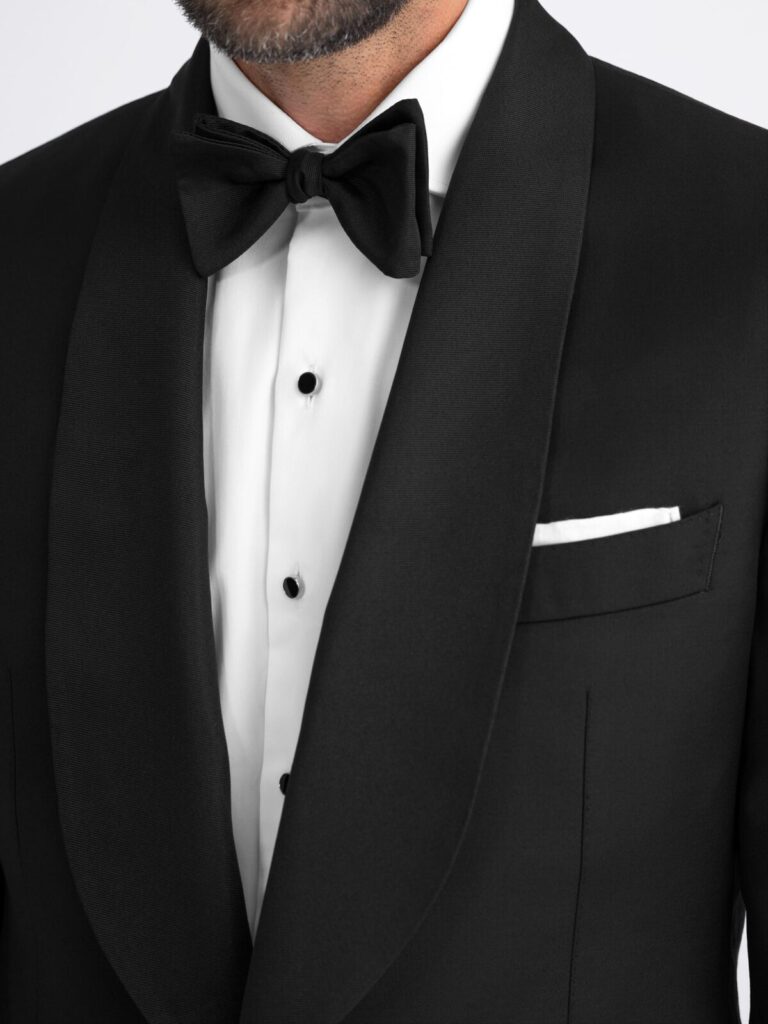
Tuxedo Colors & Fabrics
- Classic Black Tuxedo – The gold standard for black tie events, you can’t go wrong by going classic.
- Midnight Blue Tuxedo – A subtle alternative to black, midnight blue often looks richer under evening lighting.
- White or Ivory Tuxedo – Typically worn for warm-weather or destination events, white or ivory offers a great alternative. If you’re a guest at a wedding, it’s worth checking with the bride and groom if your white tux is appropriate.
- Velvet or Textured Tuxedos – Great for statement-making formalwear, velvet, and textured tuxedos are strong options for seasonal events or New Year’s Eve.
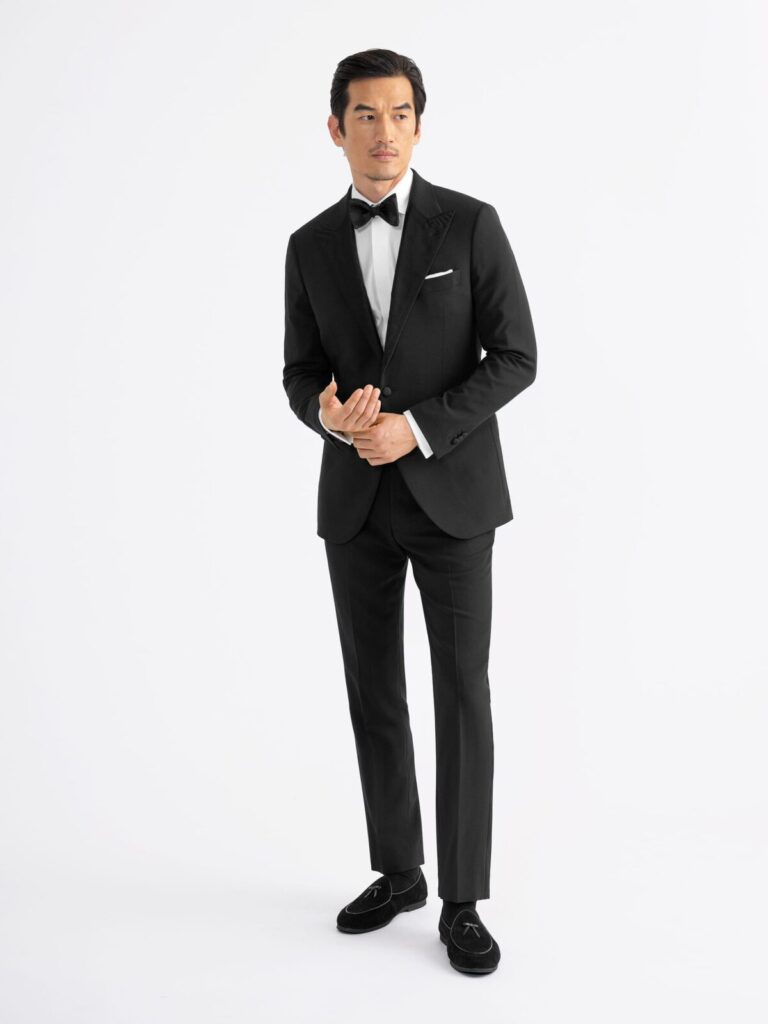
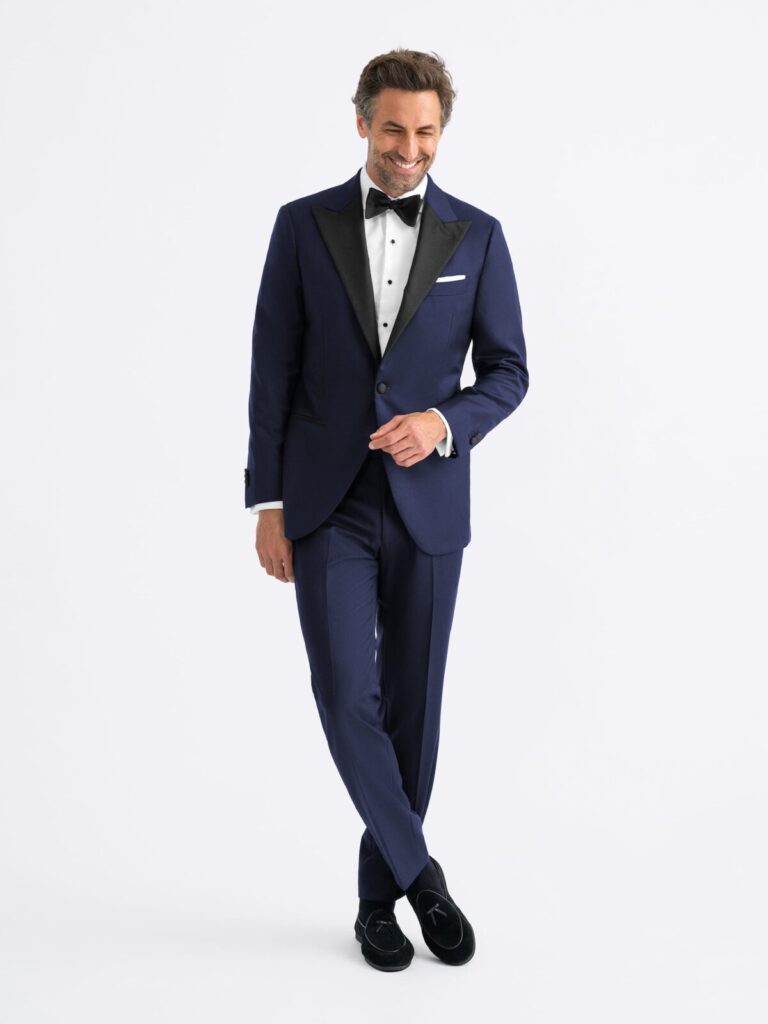
Tuxedo vs. Dinner Jacket
- Tuxedo – A tuxedo is always worn with matching trousers, traditionally in black or midnight blue.
- Dinner Jacket – A patterned or colored jacket, often paired with black tuxedo trousers for an alternative take on black tie. Historically, this was something people changed into for supper.
- Smoking Jacket – People often mix up smoking jackets and dinner jackets. A smoking jacket is closer to a robe. It’s usually made of velvet and is worn around the house.
How to Style a Tuxedo: The Key to Nailing Black Tie
Once you’ve chosen your tuxedo construction, collar style, and color, it’s time to style it. Knowing how to style a tuxedo correctly ensures a polished and sophisticated appearance.
Choosing a Tuxedo Shirts
- Pleated Front – A classic option with vertical pleats, perfect for traditional black tie looks.
- Piqué Bib Front – Features a textured bib panel for a more formal touch.
- Plain Front – A minimalist, modern take, typically worn with tuxedo studs.
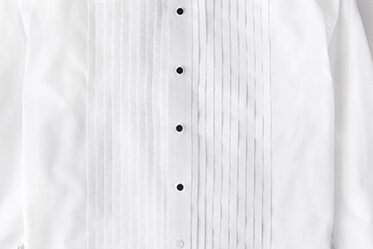
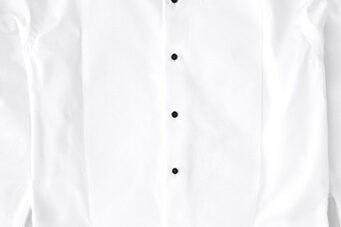
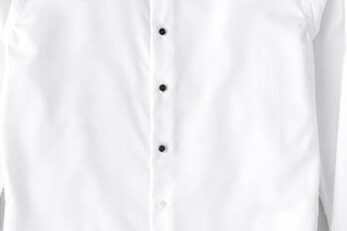
It’s important to wear a true tuxedo shirt, but which style you choose is personal. We recommend avoiding having too much going on. For example, if you wear something double-breasted, skip busier tuxedo shirt styles like pleated or bib fronts to avoid a busy look. Read our guide, Proper Cloth Tuxedo Shirt Styles, for a deeper dive into tuxedo shirt options.
Essential Tuxedo Accessories
- Bow Tie – A bow tie, usually silk, is considered part of the tuxedo. You haven’t completed the look unless you have a bow tie. Some have strong opinions on pre-tied vs. traditional bow tie, which is tied yourself. If you want to go very traditional, go for the self-tied option; if you’re new to bow ties, go for the pre-tie.
- Waistcoat – Like the vest that makes a two-piece suit a three-piece suit, the waistcoat goes under your jacket. These look great with single-breasted jackets but are not recommended with double-breasted.
- Cummerbund – A cummerbund is a wide piece of silk that goes around the waist in place of a waistcoat.
- Cufflinks – If you buy a traditional tuxedo shirt, you’ll have French cuffs, which means there won’t be buttons. Fasten the cuffs with The cuff is fastened with cuff links.
- Studs – As with cuffs, traditional tuxedo shirts won’t have buttons. Studs fasten the shirt. Ideally, your studs and cufflinks match.
- Formal Shoes – Traditionally, you wear a tuxedo with patent leather Oxfords. Patent leather is the black, gleaming material worn with tuxedos and military uniforms. Oxfords (vs. derbys) have a closed lacing system (where the eyelet tabs are stitched and should touch when closed. The shoe brand Cobbler Union has a complete write-up on the difference between these two shoes. You can also wear velvet slippers depending on the level of formality. If you want to go super traditional, there’s also a shoe called an “opera pump” worn for events in the 17th and 18th centuries.
Common Tuxedo Mistakes to Avoid
Many people won’t notice small mistakes. But you didn’t come to a tuxedo guide to get it almost right. Here are some common mistakes to avoid:
- Wearing a Necktie Instead of a Bow Tie – A dead giveaway that the dress code has been misinterpreted. You’re not really in black tie or wearing a full tux with a necktie.
- Pairing a Tuxedo with a Standard Dress Shirt – A tuxedo shirt has a distinct look, especially with studs, so avoid using your everyday white dress shirt.
- Not Wearing Proper Footwear – Black shoes that lack the shine of patent leather will stand out, which is okay if you’ve chosen something else appropriate, like velvet slippers or pumps.
Final Thoughts: Finding the Perfect Tuxedo
Black tie has a lot of rules. It can, therefore, feel constricting. But there’s a lot of room for variety and self-expression between the jacket’s construction, lapels, colors, material, footwear, and accessories.
Beyond our tuxedo guide, Proper Cloth offers a range of options with classic colors like midnight blue and black. Occasionally, we also carry ivory or seasonal colors. You can select from peak, notch, shawl lapels, and all the classic accessories. Best of all, we offer a tremendous amount of customization options. This means you can take an existing model and put your spin on it. Additional customizations, like jacket vents, pocket styles, and monograms, allow you to personalize and style the jacket to your tastes. If you’ve read the tuxedo guide and are not sure where to start, we offer free styling advice so you can learn about fit, style, and accent details from an expert.



Want to read more? Take a peek at our guide to summer wedding fabrics.